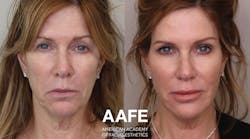Should your practice give Botox (and other cosmetic procedures) a shot?
As celebrities become more transparent about their use of cosmetic injectables and plastic surgery, more Americans are turning to these procedures as well. What was once considered a shameful secret is now seen as an essential step in reclaiming one’s self-esteem and overall mental and physical health. Society is more aware of these services and now engages in open dialogue about the concerns and advantages of Botox, Juvederm, and similar treatments.
Increased understanding equals increased use
The American Society of Plastic Surgeons (ASPS) immediate-past president Gregory A. Greco, DO, FACS, points out in a 2022 report that this is good news. Bringing medical subjects out of the shadows into the light always benefits patients. “There is also a better understanding of what plastic surgery is about at its core: healing, self-actualization, improving quality of life and helping patients achieve results through innovative, evidence-based medicine that prioritizes safety and efficacy,” Greco writes in the report.1
The ASPS report shows that, between 2019 and 2022, the use of Botox increased by 73% and Juvederm by 73%.1
The advantages of cosmetic procedures in a dental setting
Many of these procedures are available in dental practices, and they help our patients with their health and wellness. Allowing clients to come to one place for cosmetic and dental needs means lower costs and less hassle for them. Also, minimally invasive cosmetic procedures such as Botox and Juvederm are best performed on the face by professionals who are most familiar with the muscular and skeletal structure of the face, neck, and head. That is, a dentist.
One question patients looking into cosmetic procedures ask is, “Will this conflict with my dental work?” Often, the answer is, “Yes, unless you have a dentist perform both.” This can be true even when the cosmetic procedure in question is Botox treatment for fine forehead lines. The dental professional understands the location of facial nerves better than an esthetician and, therefore, can do a better job.
Two significant applications of Botox in dentistry are in managing temporomandibular joint (TMJ) disorders and in treating bruxism. TMJ and tooth grinding affect many people, and Botox can achieve relaxation of the tight muscles responsible. This provides relief to the patient, alleviating pain in TMJ and allowing the joint to heal. For bruxism, relaxing the jaw muscles responsible for tooth grinding reduces the intensity and frequency of clenching and promotes overall oral health.
When we deal with cosmetic dental treatments, such as veneers or dental implants, using Botox at the same time can achieve optimal results for our patients. Using this injection to relax specific facial muscles, we can ensure that the client’s smile appears more natural and works in harmony with our dental procedures.
Possible drug interaction
Clients who plan to get cosmetic treatments from an esthetic clinic can be advised to schedule dental and esthetic appointments two weeks apart to avoid complications from a variety of issues between the two kinds of procedures. One important issue to keep in mind when having esthetic treatments and dental procedures performed by different professionals is the issue of medication.
Dentists know how drugs can interact with each other and with treatments and procedures. Interactions between prescriptions and over-the-counter medications could affect the efficacy and interactions of Botox and the drug it is administered with. Antibiotics, blood thinners, muscle relaxants, sleeping pills, cold or allergy medicine, and bronchodilators are a few of the medications we know we need to be aware of.
Insurance considerations
Another factor in dental practices performing cosmetic treatments with Botox is that the client’s insurance plan may not cover the procedures. The FDA has not approved the use of Botox in dental procedures, so this is considered an “off-label” use.
Also, because Botox does not have FDA approval, not all dental practices are legally allowed to administer it. MLMIC Insurance Company in New York, which provides dentist professional liability insurance, studied the possible issues facing New York dental providers regarding the use of Botox and similar off-label treatments.
“There is no exclusive list of accepted therapeutic or cosmetic uses for Botox in dentistry. This, plus the lack of FDA approval specifically for dental applications, makes its use subject to regulatory compliance issues and increases the risk of professional misconduct charges and malpractice allegations,” MLMIC writes in a blog.2
“As part of a restorative or maintenance-related dental plan, dentists can use Botox to treat dental patients,” the blog author states. “However, dentists cannot use Botox solely as a cosmetic treatment for patients. In addition, even when properly used by dentists, Botox poses increased risks related to competence, informed consent, and advertising liability. Dentists need to be aware of these risks and should talk to their professional liability insurer before beginning to offer Botox treatments.”2
The suggestions in the MLMIC article are based on New York State law. Dentists in other states can contact the ADA for information from their state dental boards to learn about their state’s laws.
Editor's note: This article originally appeared in DE Weekend, the newsletter that will elevate your Sunday mornings with practical and innovative practice management and clinical content from experts across the field. Subscribe here.
References
- 2022 ASPS Procedural Statistics Release. American Society of Plastic Surgeons. Accessed June 4, 2024. https://www.plasticsurgery.org/documents/news/Statistics/2022/plastic-surgery-statistics-report-2022.pdf
- The risks of offering Botox in dentistry: a legal perspective. MLMIC Insurance Company. April 18, 2023. Accessed June 4, 2024. https://www.mlmic.com/dentists/blog/botox-in-dentistry
About the Author
Lana Rozenberg, DDS
Lana Rozenberg, DDS, is a board-certified cosmetic dentist and founder of Rozenberg Dental NYC. Her practice on New York’s Upper East Side caters to celebrities and everyday New Yorkers alike. Dr. Rozenberg has over 25 years of experience in cosmetic dentistry, and her primary focus is on helping patients transform and restore their smiles to find new confidence. Her practice offers a range of procedures, including crowns, inlays, onlays, veneers, Botox, Invisalign, and more.


